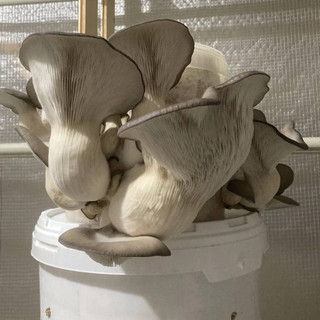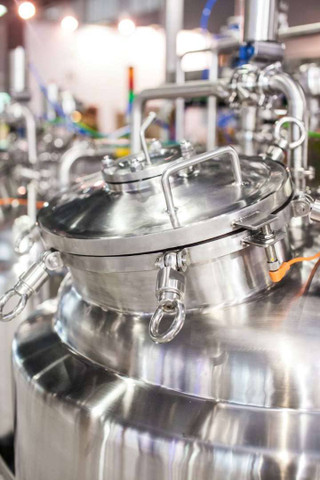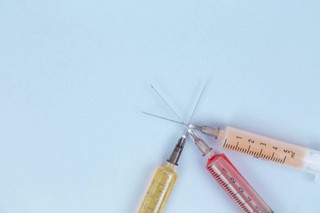How To Grow Mushrooms in Buckets and Containers [Ultimate Guide]
Posted by Troy Cosky, Founder FunGuy Grow Supply on 21st Apr 2023

How To Grow Mushrooms in Buckets [Ultimate Guide]
In this ultimate guide, we'll be teaching you how to grow delicious and nutrient-packed mushrooms in buckets and containers with ease. Our comprehensive step-by-step bucket cultivation instructions are perfect for anyone who is passionate about mushroom gardening and wants to produce high-quality organic products bursting with unique flavors. You will learn everything from setting up your bucket or container to harvesting your mouth-watering organic products rich in nutritional value. So let's get started on your journey towards growing mushrooms that are out-of-this-world delightful!
How to Select and Cultivate the Right Type of Mushrooms in Buckets and Containers.

Selecting the ideal type of mushroom is vital when it comes to growing them in buckets and containers. Among the most favored varieties that suit this cultivation method include oyster mushrooms, shiitake mushrooms, and portobello mushrooms. Different types of mushrooms have distinct requirements that need consideration before settling on the one you want to grow. Conducting extensive research on each variety will help you make well-informed decisions during selection without unnecessary hesitation.
Creating the Perfect Conditions for Optimal Mushroom Growth in Buckets.

To ensure the growth and development of your mushroom garden in containers or buckets is optimal, it is critical to start by drilling appropriate holes. These openings facilitate drainage for the substrate while also promoting air circulation which provides favorable conditions for mushroom growth. To do this correctly, create a diamond pattern by using a drill to make holes in the container, spaced about 2 inches apart. The holes should be made in a diamond pattern, with each diamond being about 4 inches wide. Creating the diamond pattern is an essential step in inoculating your substrate with mushroom spawn. This fundamental step will set you on course towards building a thriving mushroom garden that supports healthy crop yield.
Maintaining the Ideal Moisture and pH Levels for Successful Mushroom Growth
In order to grow mushrooms successfully, it's crucial to maintain the ideal moisture content and pH levels in your growing containers - this is where measuring tools like a pH meter or test strips can come in handy! For most mushroom substrates, a moisture content of around 60-70% is ideal (although different substrates may require slight variations). Excessive watering must be avoided to prevent potential problems such as mold growth.

While the ideal pH range for mushroom growth is typically between 5.5 and 7.0, it's important to keep track of specific variations depending on the substrate you're using and the species you're growing - this is where acidifying agents such as vinegar or citric acid can come in handy if you need to lower your substrate's acidic levels (or hydrated lime if your substrate requires higher alkaline). You can measure both moisture content and pH levels with measurement tools such as a moisture meter or pH meter/test strips.
By carefully monitoring these critical factors throughout each stage of growth, you'll help ensure an optimal harvest that will deliver richly flavorful mushrooms perfect for cooking up into delicious meals!
How to Properly Sterilize or Pasteurize Your Mushroom Substrate:
Sterilizing and pasteurizing the substrate is crucial when growing mushrooms in buckets. This eliminates unwanted bacteria and fungi that can compete with the mycelium and prevent mushroom growth. Several methods can be applied when pasteurizing or sterilizing substrate based on an individual basis. Each technique has its unique advantages and disadvantages that should be well-considered before applying.

- Heat Treatment: One of the most common approaches is heat treatment whereby you expose your substrate material to high temperatures for a specific period to eliminate all contaminants. While this method effectively eradicates all microorganisms present in the substrate, it also has the downside of compromising some of the nutrients required for optimal mushroom yields. Heat treating can be done using an oven or pressure cooker, and the recommended temperature and duration may vary depending on the substrate.
- Cold-Water Pasteurization: Another way of sterilizing the growing medium is through cold-water pasteurization. This process involves soaking the substrate in chilly water for a couple of hours or days. This method is less harsh than heat treating and preserves more nutrients in the substrate, but it may not be as effective at killing all microorganisms. Cold-water pasteurization is commonly used for straw-based substrates.
- Hydrated Lime: Hydrated lime is another effective means to regulate pH levels and eradicate bacteria and fungi. This method involves mixing hydrated lime with water and adding it to the substrate. The pH level of the substrate should be checked after adding hydrated lime to ensure that it falls within the optimal range for mushroom growth.
By applying these techniques carefully, you can ensure that your mushroom substrate is free of contaminants and well-prepared for the growth of healthy and delicious mushrooms!
Step 1: Gather Materials for Growing Mushrooms in Buckets and Containers
To start growing mushrooms at home in buckets or containers, you will need to gather a few essential supplies. These items include:

- A large plastic bucket or container that allows for proper drainage and enough space for the mushrooms to grow
- Mushroom spawn, which is a form of fungal seed that can be purchased from suppliers across the globe
- An organic substrate such as straw, sawdust, or coffee grounds, to create an ideal environment for optimal growth of your fungi colonies
- A drill with a specific 5/16-inch drill bit, to make holes in the buckets and containers where the mushroom spawn can be inserted
- Wax or masking tape
- Sterilized gloves
- A spray bottle filled with fresh water, for misting
- A thermometer, to monitor temperature
- A hygrometer, to monitor humidity
- A light source
- Plastic wrap
It's important to have all of these materials ready before beginning the process of growing mushrooms, as each item plays a critical role in creating the optimal environment for your mushrooms to grow.
Step 2: Preparing the Container for Optimal Mushroom Growth
To ensure the growth and development of your mushroom garden in containers or buckets is optimal, it is critical to start by drilling appropriate holes. These openings facilitate drainage for the substrate while also promoting air circulation which provides favorable conditions for mushroom growth. To do this correctly using a drill machine maker several draining holes at the bottom of an empty container then space additional ones about 2 inches apart around its sides. This fundamental step will set you on course towards building a thriving mushroom garden that supports healthy crop yield.

Materials needed for preparing the container for mushroom growth:
- Drill machine
- Container or bucket with lid
- 1/4 inch drill bit
- Marker or pen for marking the holes
Step 3: Inoculating Your Substrate with Mushroom Spawn
After creating the diamond pattern, you can add the mushroom spawn to the substrate. The amount of spawn required depends on the size of your container and the substrate you are using. As a general rule, use about 10-15% spawn by weight of your substrate. For example, for every 10 pounds of straw, you would need 1.1–1.5 pounds of spawn.
To ensure uniform colonization of the substrate, it is crucial to evenly disperse the spawn throughout the container. Add a small amount of spawn to each hole to ensure they are adequately filled. Avoid burying the spawn too deeply, as this can slow down the colonization process. Aim for a depth of about 1 inch.

Spacing is also important when inoculating your substrate. Space the holes evenly, and avoid overcrowding the container. Overcrowding can lead to competition between the mushroom mycelium and slower colonization times.
Once the mushroom spawn has been added, cover the container with a lid or plastic wrap to create a humid environment. Place the container in a dark, warm spot so that the substrate can be entirely colonized by mycelium before initiating fruiting.
Step 4: Properly Packing and Covering Your Mushroom Substrate
In order to grow delicious mushrooms in buckets or containers, it is essential to properly fill the container with the right mixture. After mixing the mushroom spawn with either sawdust or straw, it's time to pack everything into the bucket firmly to ensure successful growth. It's crucial that the entire surface of your substrate remains covered throughout the growing process. Therefore, ensuring that every single inch of each bucket is filled completely up until it reaches its maximum volume capacity should be a top priority while following these steps.
Step 5: How to Promote Fruiting
Several key steps must be taken to successfully grow mushrooms in buckets:

- Cover the top of the bucket with a plastic bag or secure lid to ensure that the level of moisture remains constant within the container.
- Place the bucket in an area devoid of light and at a temperature that promotes accelerated growth, such as a basement or closet.
- It is essential to keep the mixture moist by spraying water daily onto its surface.
Within just a few weeks after properly executing these methods, you'll begin observing small mushrooms sprouting out.
Environmental Conditions for Fruiting:
Once the substrate is fully colonized with mycelium, the fruiting process can begin. Fruiting is the stage when the mushrooms start to grow and develop. Depending on the type of mushroom, different climatic conditions are needed for fruiting, but generally, they need:

Temperature:
The optimal temperature for mushroom growth varies among different species. Generally, cooler temperatures ranging from 60-75°F (15-24°C) are favored by most mushrooms during fruiting. However, certain species like oyster mushrooms thrive in warmer temperatures of around 75-80°F (24-27°C).
Light:
While some mushroom species require light for fruiting, others do not. If your mushrooms require light, place them in a location where they will receive indirect light, as direct sunlight can be harmful to the fruiting process.
Air exchange:
Mushrooms require a steady flow of fresh air to grow and develop properly. A simple way to provide air exchange is to fan the mushrooms several times a day. You can use either an electric fan or a piece of cardboard to achieve this manually.
Step 6: Harvesting and Maximizing Yield and Quality
Once the mushrooms have reached maturity, they are ready for harvesting. The timing of harvest is critical for maximizing yield and quality. Here are some general guidelines for harvesting different mushroom species:

- Button mushrooms: Harvest when the caps have fully separated from the stem and the gills are visible.
- Shiitake mushrooms: Harvest when the caps have flattened out and the edges are starting to turn upwards.
- Oyster mushrooms: Harvest when the caps are fully grown and the edges are starting to curl upwards.
There are two simple methods to harvest your mushrooms: gently twist them off the substrate or carefully cut them off with a sharp knife. To ensure that the mushrooms retain their optimal quality and flavor, it is essential to harvest them prior to the point when the caps begin to open and release their spores.
Adhering to these guidelines will guarantee that you collect your mushrooms at the optimum time and in the appropriate circumstances, thus maximizing the amount and quality of your harvest.
Scaling Up and Commercial Mushroom Farming:
In order to scale up a mushroom growing operation, it is important to have a reliable source of bulk substrate materials. This can involve sourcing large quantities of straw, sawdust, or other substrates from local farmers or suppliers. It may also be necessary to invest in equipment to automate certain aspects of the growing process, such as substrate mixing or sterilization.
As the operation grows, it may become necessary to manage a team of workers to handle tasks such as inoculation, harvesting, and packaging. Effective teamwork demands excellent communication and organization skills. It also calls for a thorough grasp of every worker's limitations as well as their individual strengths.

In addition to these logistical considerations, scaling up a mushroom growing operation also requires a commitment to maintaining quality and efficiency. This may involve implementing standardized procedures for substrate preparation, inoculation, and fruiting, as well as monitoring and adjusting environmental conditions as needed to ensure optimal mushroom growth.
Effective communication and proficient organization skills are essential, along with a thorough comprehension of the abilities and constraints of every team member. By following best practices and learning from experienced growers, anyone can achieve success in this exciting and rewarding field.
Conclusion
Concluding your mushroom growing journey in buckets and containers is nothing but sheer joy and gratification that delivers the taste of fresh organic produce right at your doorstep. By adhering to specific guidelines like selecting an apt mushroom variety, assembling essential equipment and materials for smooth operation during the crop cycle and preparing the mushroom spawns with utmost care are crucial factors for cultivating nutritious fungi using this contemporary methodology indoors or outdoors. By following these simple steps to set up a spacious bucket with a
supportive substrate mixture, you can enjoy a bountiful harvest of
fresh, delicious mushrooms that are sure to satisfy your appetite. You'll savor every moment spent on this satisfying hobby!
Ready to start growing your own delicious mushrooms? Visit FunGuy Grow Supply for all your mushroom growing needs!

![How To Grow Mushrooms in Buckets and Containers [Ultimate Guide] How To Grow Mushrooms in Buckets and Containers [Ultimate Guide]](https://cdn11.bigcommerce.com/s-cj1hz3pz46/images/stencil/1000x600/uploaded_images/image-of-oyster-mushrooms-to-growing-in-buckets-and-containers-oyster-species-of-mushrooms-for-bucket-cultivation.jpg?t=1682048013)